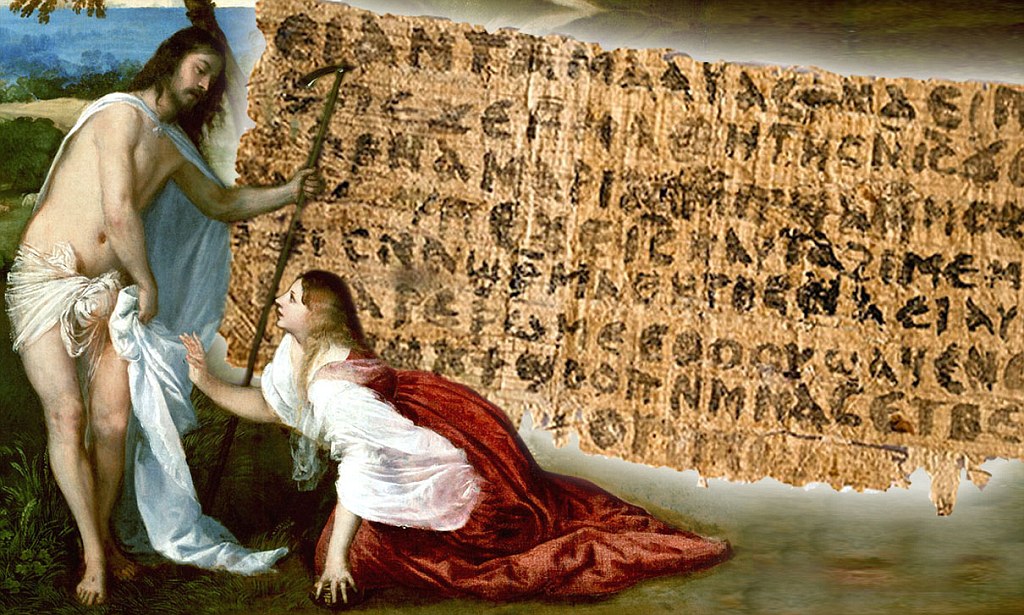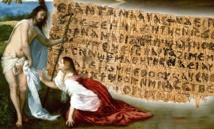Its discovery in 2012 caused a stir. Since Christian tradition has long held that Jesus was not married, it renewed long-running debates over celibacy and the role of women in the church.
The Vatican's newspaper declared it a fake, along with other scholars who doubted its authenticity based on its poor grammar, blurred text and uncertain origin.
Never before has a gospel referred to Jesus being married, or having women as disciples.
But a new scientific analysis of the papyrus and the ink, as well as the handwriting and grammar, show that the document is ancient.
"No evidence of modern fabrication ("forgery") was found," the Harvard Divinity School said in a statement.
The palm-sized fragment likely dates to between the sixth and ninth centuries, and could have been written as early as the second century CE (common era), said the study results published in the Harvard Theological Review.
Radiocarbon dating of the papyrus and a study of the ink using Micro-Raman spectroscopy was done by experts at Columbia University, Harvard University and the Massachusetts Institute of Technology.
"The team concluded the papyrus' chemical composition and patterns of oxidation are consistent with old papyrus by comparing the GJW (Gospel of Jesus' Wife) fragment with a fragment of the Gospel of John," said the study.
"Current testing thus supports the conclusion that the papyrus and ink of GJW are ancient."
- Anonymous origins -
The origin of the papyrus is unknown. Karen King, a historian at Harvard Divinity School, received it from a collector -- who asked to remain anonymous -- in 2012.
King, a historian of early Christianity, said the science showing the papyrus is ancient does not prove that Jesus was married.
"The main topic of the fragment is to affirm that women who are mothers and wives can be disciples of Jesus -- a topic that was hotly debated in early Christianity as celibate virginity increasingly became highly valued," King said in a statement.
"This gospel fragment provides a reason to reconsider what we thought we knew by asking what the role claims of Jesus's marital status played historically in early Christian controversies over marriage, celibacy, and family."
The fragment measures four by eight centimeters (1.6 by 3.2 inches).
King said its late date -- written centuries after Jesus's death -- means the author did not know Jesus personally.
Its crude appearance and grammatical errors suggest the writer had no more than an elementary education, she added.
Leo Depuydt, a professor of Egyptology at Brown University, wrote an article, also published in the Harvard Theological Review, describing why he believes the document is fake.
"The papyrus fragment seems ripe for a Monty Python sketch," he wrote.
He noted grammatical errors and that the words "my wife" appear to be emphasized in bold letters, which are not featured in other ancient Coptic texts.
"As a student of Coptic convinced that the fragment is a modern creation, I am unable to escape the impression that there is something almost hilarious about the use of bold letters," he wrote.
King published a rebuttal to Depuydt's criticisms, saying in part that blotted ink was common and that the letters below "my wife" are even darker.
----------------------------------------------------------------
The Vatican's newspaper declared it a fake, along with other scholars who doubted its authenticity based on its poor grammar, blurred text and uncertain origin.
Never before has a gospel referred to Jesus being married, or having women as disciples.
But a new scientific analysis of the papyrus and the ink, as well as the handwriting and grammar, show that the document is ancient.
"No evidence of modern fabrication ("forgery") was found," the Harvard Divinity School said in a statement.
The palm-sized fragment likely dates to between the sixth and ninth centuries, and could have been written as early as the second century CE (common era), said the study results published in the Harvard Theological Review.
Radiocarbon dating of the papyrus and a study of the ink using Micro-Raman spectroscopy was done by experts at Columbia University, Harvard University and the Massachusetts Institute of Technology.
"The team concluded the papyrus' chemical composition and patterns of oxidation are consistent with old papyrus by comparing the GJW (Gospel of Jesus' Wife) fragment with a fragment of the Gospel of John," said the study.
"Current testing thus supports the conclusion that the papyrus and ink of GJW are ancient."
- Anonymous origins -
The origin of the papyrus is unknown. Karen King, a historian at Harvard Divinity School, received it from a collector -- who asked to remain anonymous -- in 2012.
King, a historian of early Christianity, said the science showing the papyrus is ancient does not prove that Jesus was married.
"The main topic of the fragment is to affirm that women who are mothers and wives can be disciples of Jesus -- a topic that was hotly debated in early Christianity as celibate virginity increasingly became highly valued," King said in a statement.
"This gospel fragment provides a reason to reconsider what we thought we knew by asking what the role claims of Jesus's marital status played historically in early Christian controversies over marriage, celibacy, and family."
The fragment measures four by eight centimeters (1.6 by 3.2 inches).
King said its late date -- written centuries after Jesus's death -- means the author did not know Jesus personally.
Its crude appearance and grammatical errors suggest the writer had no more than an elementary education, she added.
Leo Depuydt, a professor of Egyptology at Brown University, wrote an article, also published in the Harvard Theological Review, describing why he believes the document is fake.
"The papyrus fragment seems ripe for a Monty Python sketch," he wrote.
He noted grammatical errors and that the words "my wife" appear to be emphasized in bold letters, which are not featured in other ancient Coptic texts.
"As a student of Coptic convinced that the fragment is a modern creation, I am unable to escape the impression that there is something almost hilarious about the use of bold letters," he wrote.
King published a rebuttal to Depuydt's criticisms, saying in part that blotted ink was common and that the letters below "my wife" are even darker.
----------------------------------------------------------------









 Home
Home Politics
Politics











